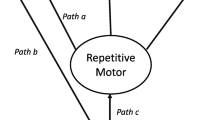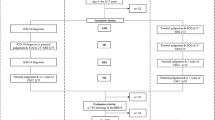Abstract
Restricted, repetitive behaviors and interests (RRBIs) occur commonly in young children in the course of typical development, but too frequent or persistent RRBIs have been linked to a variety of psychosocial and neurodevelopmental disorders. Unfortunately, a lack of psychometrically sound, feasible instruments stymies RRBI study and intervention in early childhood. Therefore, this study validated an extant RRBI measure (i.e., Repetitive Behavior Scale for Early Childhood; RBS-EC) for predominately neurotypical community children ages 2–7 years via an MTurk survey of 300 caregivers. Confirmatory factor analyses best supported a 4-factor model for the RBS-EC (i.e., repetitive motor, rituals and routines, restricted interests, self-directed behaviors). RBS-EC scores varied significantly with age and gender; namely, RRBIs were typically (1) less frequent but more problematic with older versus younger children and (2) more frequent and problematic with boys versus girls. Findings extend the RBS-EC’s utility in RRBI assessment and treatment during early childhood.





Similar content being viewed by others
References
American Psychiatric Association (2013) Diagnostic and statistical manual of mental disorders, 5th edn. American Psychiatric Publishing, Arlington, VA
Kim SH, Lord C (2010) Restricted and repetitive behaviors in toddlers and preschoolers with autism spectrum disorders based on the Autism Diagnostic Observation Schedule (ADOS). Autism Res 3(4):162–173
Oakes A, Thurman AJ, McDuffie A, Bullard LM, Hagerman RJ, Abbeduto L (2015) Characterising repetitive behaviours in young boys with fragile X syndrome. J Intell Disabil Res 60(1):54–67
Tröster H (1994) Prevalence and functions of stereotyped behaviors in nonhandicapped children in residential care. J Abnorm Child Psychol 22(1):79–97
Moss J, Oliver C, Arron K, Burbidge C, Berg K (2009) The prevalence and phenomenology of repetitive behavior in genetic syndromes. J Autism Dev Disord 39(4):572–588
Ruzzano L, Borsboom D, Geurts HM (2015) Repetitive behaviors in autism and obsessive–compulsive disorder: new perspectives from a network analysis. J Autism Dev Disord 45(1):192–202
Evans DW, Leckman JF, Carter A, Reznick JS, Henshaw D, King RA, Pauls D (1997) Ritual, habit, and perfectionism: the prevalence and development of compulsive-like behavior in normal young children. Child Dev 68:58–68
Larkin F, Meins E, Centifanti LCM, Fernyhough C, Leekam SR (2017) How does restricted and repetitive behavior relate to language and cognition in typical development? Dev Psychopathol 29:863–874
Leekam S, Tandos J, Mcconachie H et al (2007) Repetitive behaviours in typically developing 2-year-olds. J Child Psychol Psychiat 48(11):1131–1138
Wolff JJ, Boyd BA, Elison JT (2016) A quantitative measure of restricted and repetitive behaviors for early childhood. J Neurodev Disord 8:27–37
Pietrefesa AS, Evans DW (2007) Affective and neuropsychological correlates of children’s rituals and compulsive-like behaviors: continuities and discontinuities with obsessive-compulsive disorder. Brain Cogn 65:36–46
Berkson G, Tupa M (2000) Early development of stereotyped and self-injurious behaviors. J Early Interv 23:1–19
Kravitz H, Boehm JJ (1971) Rhythmic habit patterns in infancy: their sequence, age of onset, and frequency. Child Dev 42:399–413
Thelen E (1981) Rhythmical behavior in infancy: an ethological perspective. Dev Psychol 17:237–257
Arnott B, McConachie H, Meins E et al (2010) The frequency of restricted and repetitive behaviors in a community sample of 15-month-old infants. J Dev Behav Pediatr 31:223–229
Piaget J (1952) The origins of intelligence in children. International Universities Press, New York
Harrop C, McConachie H, Emsley R, Leadbitter K, Green J (2014) PACT consortium. Restricted and repetitive behaviors in autism spectrum disorders and typical development: cross-sectional and longitudinal comparisons. J Autism Dev Disord 44(5):1207–1219. https://doi.org/10.1007/s10803-013-1986-5
Macdonald R, Green G, Mansfield R et al (2007) Stereotypy in young children with autism and typically developing children. Res Dev Disabil 28(3):266–277. https://doi.org/10.1016/j.ridd.2006.01.004
Ray-Subramanian CE, Weismer SE (2012) Receptive and expressive language as predictors of restricted and repetitive behaviors in young children with autism spectrum disorders. J Autism Dev Disord 42:2113–2120
Zohar AH, Felz L (2001) Ritualistic behavior in young children. J Abnormal Child Psychol 29(2):121–128
Evans DW, Kleinpeter FL, Slane MM, Boomer KB (2014) Adaptive and maladaptive correlates of repetitive behavior and restricted interests in persons with Down syndrome and developmentally-matched typical children: a two-year longitudinal sequential design. PLoS ONE 9(4):e93951
Whitehouse AJ, Watt HJ, Line EA, Bishop DV (2009) Adult psychosocial outcomes of children with specific language impairment, pragmatic language impairment and autism. Int J Lang Commun Disord 44(4):511–528
Cevikaslan A, Evans DW, Dedeoglu C, Kalaca S, Yazgan Y (2014) A cross-sectional survey of repetitive behaviors and restricted interests in a typically developing Turkish child population. Child Psychiatry Hum Dev 45:472–482
Glenn S, Cunningham C, Nananidou A (2012) A cross-sectional comparison of routinized and compulsive-like behaviors in typical children aged from 2 to 11 years. Eur J Dev Psychol 1:1–17
Glenn S, Cunningham C (2007) Typical or pathological? Routinized and compulsive-like behaviours in children and young people with Down syndrome. Intellect Dev Disabil 45:246–256
Tregay J, Gilmour J, Charman T (2009) Childhood rituals and executive functions. Br J Dev Psychol 27:283–296
Hiller RM, Young RL, Weber N (2014) Sex differences in autism spectrum disorder based on DSM-5 criteria: evidence from clinician and teacher reporting. J Abnorm Child Psychol 42(8):1381–1393
Antezana L, Factor RS, Condy EE, Strege MV, Scarpa A, Richey JA (2019) Gender differences in restricted and repetitive behaviors and interests in youth with autism. Autism Res 12(2):274–283
Van Wijngaarden-Cremers PJ, van Eeten E, Groen WB, Van Deurzen PA, Oosterling IJ, Van der Gaag RJ (2014) Gender and age differences in the core triad of impairments in autism spectrum disorders: a systematic review and meta-analysis. J Autism Dev Disord 44(3):627–635
Tillmann J, Ashwood K, Absoud M et al (2018) Evaluating sex and age differences in ADI-R and ADOS scores in a large European multi-site sample of individuals with autism spectrum disorder. J Autism Dev Disord 48(7):2490–2505
McFayden TC, Albright J, Muskett AE, Scarpa A (2019) Brief report: sex differences in ASD diagnosis-a brief report on restricted interests and repetitive behaviors. J Autism Dev Disord 49(4):1693–1699
Lord C, Rutter M, DiLavore PC, Risi S, Gotham K, Bishop SL (2012) Autism diagnostic observation schedule, second edition (ADOS-2) manual (Part I): modules 1–4. Western Psychological Services, Torrance, CA
Ozonoff S, Macari S, Young GS, Goldring S, Thompson M, Rogers SJ (2008) Atypical object exploration at 12 months of age is associated with autism in a prospective sample. Autism 12:457–472
Watt N, Wetherby AM, Barber A, Morgan L (2008) Repetitive and stereotyped behaviors in children with autism spectrum disorders in the second year of life. J Autism Dev Disord 38:1518–1533
Glasgow RE (2013) What does it mean to be pragmatic? Pragmatic methods, measures, and models to facilitate research translation. Health Educ Behav 40(3):257–265
Glasgow RE, Riley WT (2013) Pragmatic measures: what they are and why we need them. Am J Prev Med 45(2):237–243
Lewis CC, Proctor EK, Brownson RC (2018) Measurement issues in dissemination and implementation research. In: Brownson RC, Ga C, Proctor EK (eds) Disssemination and implementation research in health: translating science to practice, 2nd edn. Oxford University Press, New York
Lewis CC, Mettert KD, Dorsey CN et al (2018) An updated protocol for a systematic review of implementation-related measures. Syst Rev 7(1):66
American Academy of Pediatrics (2001) Committee on children with disabilities. Developmental surveillance and screening of infants and young children. Pediatrics 108:192–196
Lam KS, Aman MG (2007) The repetitive behavior scale-revised: independent validation in individuals with autism spectrum disorders. J Autism Dev Disord 37(5):855–866
Bodfish JW, Symons FW, Lewis MH (1999) The Repetitive Behavior Scale. Western Carolina Center Research Reports
Esbensen AJ, Seltzer MM, Lam KS, Bodfish JW (2009) Age-related differences in restricted repetitive behaviors in autism spectrum disorders. J Autism Dev Disord 39(1):57–66
Bishop SL, Richler J, Lord C (2006) Association between restricted and repetitive behaviors and nonverbal IQ in children with autism spectrum disorders. Child Neuropsychol 12:247–267
Richler J, Huerta M, Bishop SL, Lord C (2010) Developmental trajectories of restricted and repetitive behaviors and interests in children with autism spectrum disorders. Dev Psychopathol 22(1):55–69
Bodfish JW, Symons FJ, Parker DE, Lewis MH (2000) Varieties of repetitive behavior in autism: comparisons to mental retardation. J Autism Dev Disord 30:237–243
Lasch C, Wolff J, Elison J (2019) Examining criterion-oriented validity of the repetitive behavior scales for early childhood (RBS-EC) and the video-referenced rating of reciprocal social behavior (vrRSB). Dev Psychopathol. https://doi.org/10.1017/S0954579419001159
Carter AS, Briggs-Gowan MJ, Jones SM, Little TD (2003) The infant–toddler social and emotional assessment (ITSEA): factor structure, reliability, and validity. J Abnorm Child Psychol 31:495–514. https://doi.org/10.1023/A:1025449031360
Buhrmester MD, Talaifar S, Gosling S (2018) An evaluation of amazon’s mechanical turk, its rapid rise, and its effective use. Perspect Psychol Sci 13(2):149–154
Meade AW, Craig SB (2012) Identifying careless responses in survey data. Psychol Methods 17(3):437–455
Benjamini Y, Hochberg Y (1995) Controlling the false discovery rate: a practical and powerful approach to multiple testing. J R Stat Soc Ser B Methodol 57:289–300
Schermelleh-Engel K, Moosbrugger H, Müller H (2003) Evaluating the fit of structural equation models: tests of significance and descriptive goodness-of-fit measures. Methods Psychol Res Online 8(2):23–74
Schumacker RE, Lomax RG (2004) A beginner’s guide to structural equation modeling. Psychology Press, London
Hu LT, Bentler PM (1999) Cutoff criteria for fit indexes in covariance structure analysis: conventional criteria versus new alternatives. Struct Equ Modeling 6(1):1–55
Muthén LK, Muthén BO (1998) Mplus user’s guide. Author, Los Angeles, CA
Walters K, Christakis DA, Wright DR (2018) Are Mechanical Turk worker samples representative of health status and health behaviors in the U.S.? PLoS ONE 13(6):e0198835
Powell BJ, Stanick CF, Halko HM et al (2017) Toward criteria for pragmatic measurement in implementation research and practice: a stakeholder-driven approach using concept mapping. Implement Sci 12(1):118
Stanick CF, Halko HM et al (2019) Pragmatic measures for implementation research: development of the psychometric and pragmatic evidence rating scale (PAPERS). Transl Behav Med. https://doi.org/10.1093/tbm/ibz164
Funding
Funding for this project provided by Idaho State University Office of Research and Department of Psychology.
Author information
Authors and Affiliations
Corresponding author
Ethics declarations
Conflict of interest
The authors declare that they have no conflict of interest.
Research Involving Human Participants
All procedures performed in studies involving human participants were in accordance with the ethical standards of the institutional and/or national research committee (Idaho State University Human Subjects Committee: IRB-FY2018-268) and with the 1964 Helsinki declaration and its later amendments or comparable ethical standards.
Informed Consent
Informed consent was obtained from all individual participants included in the study.
Additional information
Publisher's Note
Springer Nature remains neutral with regard to jurisdictional claims in published maps and institutional affiliations.
Rights and permissions
About this article
Cite this article
Lachance, K., Štětinová, K., Rieske, R. et al. Repetitive Behavior Scale for Early Childhood (RBS-EC): Psychometrics and Developmental Effects with a Community Sample. Child Psychiatry Hum Dev 53, 863–875 (2022). https://doi.org/10.1007/s10578-021-01166-x
Accepted:
Published:
Issue Date:
DOI: https://doi.org/10.1007/s10578-021-01166-x




